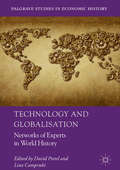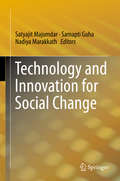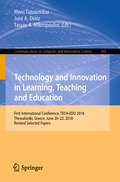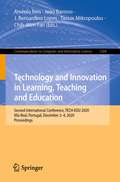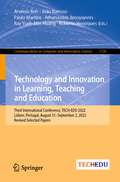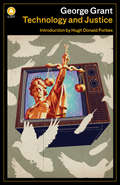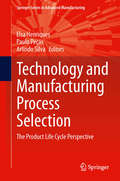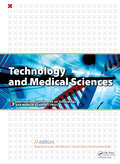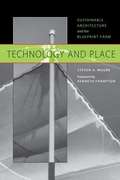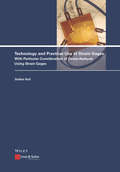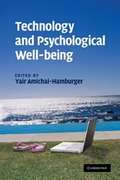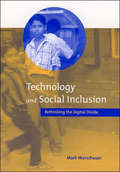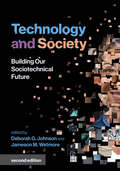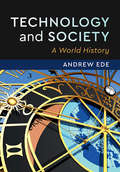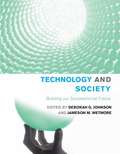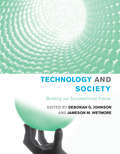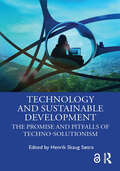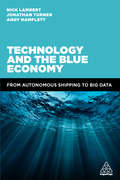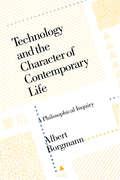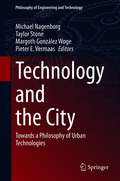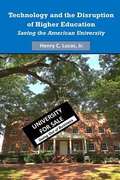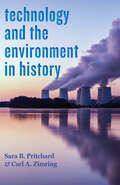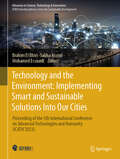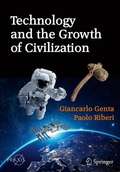- Table View
- List View
Technology and Globalisation: Networks of Experts in World History (Palgrave Studies in Economic History)
by Lino Camprubí David PretelThis book examines the role of experts and expertise in the dynamics of globalisation since the mid-nineteenth century. It shows how engineers, scientists and other experts have acted as globalising agents, providing many of the materials and institutional means for world economic and technical integration. Focusing on the study of international connections, Technology and Globalisation illustrates how expert practices have shaped the political economies of interacting countries, entire regions and the world economy. This title brings together a range of approaches and topics across different regions, transcending nationally-bounded historical narratives. Each chapter deals with a particular topic that places expert networks at the centre of the history of globalisation. The contributors concentrate on central themes including intellectual property rights, technology transfer, tropical science, energy production, large technological projects, technical standards and colonial infrastructures. Many also consider methodological, theoretical and conceptual issues.
Technology and Innovation for Social Change
by Satyajit Majumdar Samapti Guha Nadiya MarakkathTension exists between technologists and social thinkers because of the impact technology and innovation have on social values and norms, which is often viewed as damaging to the cultural fabric of a nation or society. Since the global business environment is the context in which implementation of technology and innovation takes place, it is widely accepted as the major reason for such conflicts. In this backdrop, this edited book integrates independent research from across the globe. It deals with the nature and significance of technology, innovation and social change as well as the relationships between them, and discusses the significance of social entrepreneurship from social innovation and technology perspectives. Research areas covered are related to the development and deployment of technology, innovation and knowledge in social change, capabilities of institutions, models, role of government and corporate social responsibility and community involvement. Multiple aspects of social change are discussed in the context of India, Mexico, Thailand, Cambodia, Laos, Vietnam, Ethiopia, Nigeria and other African countries. But society does not silently accept technologically enforced changes; sometimes technology is seen as an enemy of inclusive growth and for many, economic development is an anti-thesis of social change. Selected case studies on sector-specific technologies, such as the use of genetically modified seeds in agriculture, which has impacted the market and society, are critically analyzed to develop insights into the adoption of technology and its impact. At the same time it examines policy related issues, without any bias in favor of, or against, a specific technology.
Technology and Innovation in Learning, Teaching and Education: First International Conference, TECH-EDU 2018, Thessaloniki, Greece, June 20–22, 2018, Revised Selected Papers (Communications in Computer and Information Science #993)
by José A. Diniz Meni Tsitouridou Tassos A. MikropoulosThis book constitutes the thoroughly refereed post-conference proceedings of the First International Conference on Technology and Innovation in Learning, Teaching and Education, TECH-EDU 2018, held in Thessaloniki, Greece, on June 20-22, 2018. The 30 revised full papers along with 18 short papers presented were carefully reviewed and selected from 80 submissions.The papers are organized in topical sections on new technologies and teaching approaches to promote the strategies of self and co-regulation learning (new-TECH to SCRL); eLearning 2.0: trends, challenges and innovative perspectives; building critical thinking in higher education: meeting the challenge; digital tools in S and T learning; exploratory potentialities of emerging technologies in education; learning technologies; digital technologies and instructional design; big data in education and learning analytics.
Technology and Innovation in Learning, Teaching and Education: Second International Conference, TECH-EDU 2020, Vila Real, Portugal, December 2–4, 2020, Proceedings (Communications in Computer and Information Science #1384)
by João Barroso Arsénio Reis J. Bernardino Lopes Tassos Mikropoulos Chih-Wen FanThis book constitutes the thoroughly refereed post-conference proceedings of the Second International Conference on Technology and Innovation in Learning, Teaching and Education, TECH-EDU 2020, held in Vila Real, Portugal, in December 2020. Due to the COVID-19 pandemic the conference was held in a fully virtual format. The 27 revised full papers along with 15 short papers presented were carefully reviewed and selected from 79 submissions.The papers are organized in topical sections on digital resources as epistemic tools to improve STEM learning; digital technologies to foster critical thinking and monitor self and co-regulation of e-learning; Covid-19 pandemic, changes in educational ecosystem and remote teaching; transforming teaching and learning through technology; educational proposals using technology to foster learning competences.
Technology and Innovation in Learning, Teaching and Education: Third International Conference, TECH-EDU 2022, Lisbon, Portugal, August 31–September 2, 2022, Revised Selected Papers (Communications in Computer and Information Science #1720)
by Athanassios Jimoyiannis João Barroso Paulo Martins Arsénio Reis Ray Yueh-Min Huang Roberto HenriquesThis book constitutes the proceedings of the Third International Conference on Technology and Innovation in Learning, Teaching and Education, TECH-EDU 2022, was held in Lisbon, Portugal, in August/September 2022.The 21 full papers and 18 short paper presented in this volume were carefully reviewed and selected from 80 submissions. The papers are organized in the following topical sections: Emergent technologies in education; Online learning and blended learning; Computer science education and STEM; Digital tools and STEM learning; ICT and critical thinking in higher education; Digital transformation in higher education; Artificial Intelligence in Education.
Technology and Isolation
by Clive LawsonInspired by the desire to facilitate a critical intellectual dialogue between the philosophy of technology and recent developments in ontology, especially critical realism, this detailed analysis is aimed at anyone interested in the nature of technology. As well as contributing to the philosophy of technology, there are chapters on the history, sociology, psychology and economics of technology, contributing to such diverse topics as the circumstances in which the term 'technology' gained currency, the importance of technology to 'social acceleration' and the relation of technology to those with autism. The central theme of the book is the way that notions of isolation weave in and out of the classic accounts of the philosophy of technology, along with a new account of why isolation is so important.
Technology and Justice (A List)
by George GrantSix magnificent and stimulating essays examining the role of technology in shaping how we live, by one of Canada’s most influential philosophers, now reissued in a handsome A List edition.Originally published in 1986, the six essays that comprise Technology and Justice offer absorbing reflections on the extent to which technology has shaped the way we live now. George Grant explores the fate of traditional values in modern education, social behaviour, and religion, and offers his insights into some of the most contentious ethical deliberations of the past half-century.In essays ranging in content from classical philosophy to the morals of euthanasia, Technology and Justice showcases Grant’s stimulating commentary on the meaning of the North American experience.
Technology and Manufacturing Process Selection
by Elsa Henriques Paulo Pecas Arlindo SilvaThis book provides specific topics intending to contribute to an improved knowledge on Technology Evaluation and Selection in a Life Cycle Perspectives. Although each chapter will present possible approaches and solutions, there are no recipes for success. Each reader will find his/her balance in applying the different topics to his/her own specific situation. Case studies presented throughout will help in deciding what fits best to each situation, but most of all any ultimate success will come out of the interplay between the available solutions and the specific problem or opportunity the reader is faced with.
Technology and Medical Sciences
by João Manuel R.S. Tavares R.M. Natal JorgeThe use of more robust, affordable, and efficient techniques and technologies in the application of medicine is presently a subject of huge interest and demand. Technology and Medical Sciences solidifies knowledge in the fields of technology and medical sciences and to define their key stakeholders. The book is designed for academics in engineering, mathematics, medicine, biomechanics, computation sciences, hardware development and manufacturing, electronics and instrumentation, and materials science.
Technology and Place
by Steven A. MooreDeveloping "sustainable" architectural and agricultural technologies was the intent behind Blueprint Farm, an experimental agricultural project designed to benefit farm workers displaced by the industrialization of agriculture in the Rio Grande Valley of Texas. Yet, despite its promise, the very institutions that created Blueprint Farm terminated the project after just four years (1987-1991). In this book, Steven Moore demonstrates how the various stakeholders' competing definitions of "sustainability," "technology," and "place" ultimately doomed Blueprint Farm. He reconstructs the conflicting interests and goals of the founders, including Jim Hightower and the Texas Department of Agriculture, Laredo Junior College, and the Center for Maximum Potential Building Systems, and shows how, ironically, they unwittingly suppressed the self-determination of the very farm workers the project sought to benefit. From the instructive failure of Blueprint Farm, Moore extracts eight principles for a regenerative architecture, which he calls his "nonmodern manifesto. "
Technology and Practical Use of Strain Gages: With Particular Consideration of Stress Analysis Using Strain Gages
by Stefan KeilThis book is a profound compendium on strain gages and their application in materials science and all fields of engineering. It covers both the theoretical and practical aspects of strength and stress analysis using the technique of strain gages. A brief historical review about strain gage inventions is looking at the "who, when and how". The comprehensive bibliography leads to additional background information. Particular consideration is given to the stress analysis in order to verify the mechanical properties and capacity of components with focus on stability and serviceability, optimization, and safety checks, as well as in order to foresee inspection and monitoring. The practice-oriented descriptions of the principles of the measurement, installation and experimental set-ups derives from the author`s own experiences in the field. Particular emphasis is laid on the correct planning and assessment of measurements, and on the interpretation of the results. Step-by-step guidance is given for many application examples, and comments help to avoid typical mistakes. The book is an indispensable reference work for experts who need to analyze structures and have to plan measurements which lead to reliable results. The book is instructive for practitioners who must install reliable measurement circuits and judge the results. The book is also recommended for beginners to get familiar with the problems and to learn about the possibilities and the limits of the strain gage technique.
Technology and Psychological Well-being
by Yair Amichai-HamburgerIn the modern world we are surrounded by technology. Gadgets such as cell phones, portable computers, and electronic diaries accompany us throughout the day. But is this a good thing? Are we being served by these technological wonders, or have we become enslaved by them? Does constant availability via technology make us more efficient or more stressed? Is our ability to connect with others all over the world, day or night, making us more sociable or turning us into recluses in a virtual world? This book considers the impact of technology on the different spheres of our life - work, home, family and leisure - and assesses ways in which to build better communication between technology developers and society to ensure that technology enhances our lives and psychological well-being, rather than damaging them.
Technology and Social Inclusion: Rethinking the Digital Divide (The\mit Press Ser.)
by Mark WarschauerMuch of the discussion about new technologies and social equality has focused on the oversimplified notion of a "digital divide." Technology and Social Inclusion moves beyond the limited view of haves and have-nots to analyze the different forms of access to information and communication technologies. Drawing on theory from political science, economics, sociology, psychology, communications, education, and linguistics, the book examines the ways in which differing access to technology contributes to social and economic stratification or inclusion. The book takes a global perspective, presenting case studies from developed and developing countries, including Brazil, China, Egypt, India, and the United States.A central premise is that, in today's society, the ability to access, adapt, and create knowledge using information and communication technologies is critical to social inclusion. This focus on social inclusion shifts the discussion of the "digital divide" from gaps to be overcome by providing equipment to social development challenges to be addressed through the effective integration of technology into communities, institutions, and societies. What is most important is not so much the physical availability of computers and the Internet but rather people's ability to make use of those technologies to engage in meaningful social practices.
Technology and Society, second edition: Building Our Sociotechnical Future (Inside Technology)
by Edited by Deborah G. Johnson and Jameson M. WetmoreWritings by thinkers ranging from Rokeya Sakhawat Hossain to Bruno Latour that focus on the interconnections of technology, society, and values.Technological change does not happen in a vacuum; decisions about which technologies to develop, fund, market, and use engage ideas about values as well as calculations of costs and benefits. In order to influence the development of technology for the better, we must first understand how technology and society are inextricably bound together. These writings--by thinkers ranging from Bruno Latour to Francis Fukuyama--help us do just that, examining how people shape technology and how technology shapes people. This second edition updates the original significantly, offering twenty-one new essays along with fifteen from the first edition. The book first presents visions of the future that range from technological utopias to cautionary tales and then introduces several major STS theories. It examines human and social values and how they are embedded in technological choices and explores the interesting and subtle complexities of the technology-society relationship. Remedying a gap in earlier theorizing in the field, many of the texts illustrate how race and gender are intertwined with technology. Finally, the book offers a set of readings that focus on the sociotechnical challenges we face today, treating topics that include cybersecurity, geoengineering, and the myth of neutral technology.
Technology and Society: A World History
by Andrew EdeTechnology and Society: A World History explores the creative power of humanity from the age of stone tools to the digital revolution. It introduces technology as a series of systems that allowed us to solve real-world problems and create a global civilization. The history of technology is also the history of the intellectual and cultural place of our tools and devices. With a broad view of technology, we can see that some of the most powerful technologies such as education and government produce no physical object but have allowed us to coordinate our inventive skills and pass knowledge through the ages. Yet although all human communities depend on technology, there are unexpected consequences from the use of technology which, as Ede shows, form a crucial part of this rich story.
Technology and Society: Building Our Sociotechnical Future
by Deborah G. Johnson Jameson M. WetmoreTechnological change does not happen in a vacuum; decisions about which technologies to develop, fund, market, and use engage ideas about values as well as calculations of costs and benefits.
Technology and Society: Building our Sociotechnical Future (Inside Technology #28)
by Deborah G. Johnson Jameson M. WetmoreAn anthology of writings by thinkers ranging from Freeman Dyson to Bruno Latour that focuses on the interconnections of technology, society, and values and how these may affect the future. Technological change does not happen in a vacuum; decisions about which technologies to develop, fund, market, and use engage ideas about values as well as calculations of costs and benefits. This anthology focuses on the interconnections of technology, society, and values. It offers writings by authorities as varied as Freeman Dyson, Laurence Lessig, Bruno Latour, and Judy Wajcman that will introduce readers to recent thinking about technology and provide them with conceptual tools, a theoretical framework, and knowledge to help understand how technology shapes society and how society shapes technology. It offers readers a new perspective on such current issues as globalization, the balance between security and privacy, environmental justice, and poverty in the developing world. The careful ordering of the selections and the editors' introductions give Technology and Society a coherence and flow that is unusual in anthologies. The book is suitable for use in undergraduate courses in STS and other disciplines. The selections begin with predictions of the future that range from forecasts of technological utopia to cautionary tales. These are followed by writings that explore the complexity of sociotechnical systems, presenting a picture of how technology and society work in step, shaping and being shaped by one another. Finally, the book goes back to considerations of the future, discussing twenty-first-century challenges that include nanotechnology, the role of citizens in technological decisions, and the technologies of human enhancement.
Technology and Sustainable Development: The Promise and Pitfalls of Techno-Solutionism
by Henrik Skaug SætraTechnological change is at the core of all major disruptions in human history, and revolutions, wars, and general development are regularly connected to some sort of technological change. However, not all development is beneficial. While technology has fueled great innovations and rapid development, the notion of sustainable development has gained prominence as we now experience serious social, economic, and environmental challenges. This book examines whether technology can be used to fix the very problems caused by technology, as the various chapters examine different aspects related to how technology has brought us where we are today (which some will say is the best place humanity’s been at according to a range of metrics), and whether technology helps or hinders us in our efforts to solve the challenges we currently face. The issues discussed cover the three sustainability dimensions and include topics such as the materiality of AI, technology in education, AI for gender equality, innovation and the digital divide, and how technology relates to power, the political system, and capitalism. The chapters all build on the theoretical backdrop of technological change, sustainable development, and the UN’s Sustainable Development Goals are actively used throughout this book, both to examine how these goals capture or overlook central elements of sustainable development, and also to facilitate and create a common framework of engagement between the chapters. This book provides a novel combination of traditional theories that are explored through different case studies, providing the ground for a better understanding of how and when technology can –and cannot –be the enabler of sustainable development. It is thus an important resource for students of all disciplines, technologists, and those developing and applying new technologies. It is also a valuable resource for politicians and regulators attempting to harness the power of technology for good, while limiting its negative potential. The Open Access version of this book, available at www.taylorfrancis.com, has been made available under a Creative Commons [Attribution-Non Commercial-No Derivatives (CC-BY-NC-ND)] 4.0 license. Funded by Ostfold University College.
Technology and the Blue Economy: From Autonomous Shipping to Big Data
by Jonathan Turner Nick Lambert Andy HamflettSeventy percent of the planet is covered by water, and ninety percent of global economic trade is transported by sea. The oceans are inextricably linked with food security and the global economy. Technology and the Blue Economy examines the vital role that technology plays in developing the blue economy. It provides a clear, accessible picture of the current and future potential of technology within different sectors in the blue economy, such as offshore energy, ports and harbours, shipping, maritime surveillance and cyber security.Technology and the Blue Economy looks at the disruption of established business models through case studies of leading innovators, examining development issues, what they have learned and how they have transformed their current ways of working within their organizations. Along with actionable takeaways at the end of each section, readers will learn from and be inspired by the front-line experiences of Blue Economy innovators.
Technology and the Character of Contemporary Life: A Philosophical Inquiry
by Albert BorgmannBlending social analysis and philosophy, Albert Borgmann maintains that technology creates a controlling pattern in our lives. This pattern, discernible even in such an inconspicuous action as switching on a stereo, has global effects: it sharply divides life into labor and leisure, it sustains the industrial democracies, and it fosters the view that the earth itself is a technological device. He argues that technology has served us as well in conquering hunger and disease, but that when we turn to it for richer experiences, it leads instead to a life dominated by effortless and thoughtless consumption. Borgmann does not reject technology but calls for public conversation about the nature of the good life. He counsels us to make room in a technological age for matters of ultimate concern—things and practices that engage us in their own right.
Technology and the City: Towards a Philosophy of Urban Technologies (Philosophy of Engineering and Technology #36)
by Pieter E. Vermaas Michael Nagenborg Taylor Stone Margoth González WogeThe contributions in this volume map out how technologies are used and designed to plan, maintain, govern, demolish, and destroy the city. The chapters demonstrate how urban technologies shape, and are shaped, by fundamental concepts and principles such as citizenship, publicness, democracy, and nature. The many authors herein explore how to think of technologically mediated urban space as part of the human condition. The volume will thus contribute to the much-needed discussion on technology-enabled urban futures from the perspective of the philosophy of technology. This perspective also contributes to the discussion and process of making cities ‘smart’ and just. This collection appeals to students, researchers, and professionals within the fields of philosophy of technology, urban planning, and engineering.
Technology and the Disruption of Higher Education: Saving The American University
by Henry C. LucasThe purpose of this book is to explore how new technology has the potential to transform higher education. However, this same technology also has the potential to disrupt universities. Much depends on how administrators, faculty and students apply technologically enhanced learning. Technology and the Disruption of Higher Education presents details on MOOCs, blended, flipped and online classes and their role in transforming higher education based on the author's experiences teaching all of these types of courses. <P><P>These technology-enabled approaches to teaching and learning offer tremendous opportunities to schools, but they also threaten the traditional university. The book identifies some of these threats and opportunities and offers suggested strategies to take advantage of the technology. Is this technology enough to save the university system? While new ways of teaching and learning are exciting, they are only part of the puzzle. Radical change beyond what happens in the classroom is needed if our higher education system is to continue to flourish and some of these ideas are discussed in the last chapter of the book. The book is a call to action for educators to realize that the technology is both transformational and disruptive, and that some universities are going to fail in the next 15 years.
Technology and the Environment in History (Technology in Motion)
by Carl A. Zimring Sara B. PritchardNew perspectives on how envirotech can help us engage with the surrounding world in ways that are more sustainable for humanity—and the planet.Today's scientists, policymakers, and citizens are all confronted by numerous dilemmas at the nexus of technology and the environment. Every day seems to bring new worries about the dangers posed by carcinogens, "superbugs," energy crises, invasive species, genetically modified organisms, groundwater contamination, failing infrastructure, and other troubling issues. In Technology and the Environment in History, Sara B. Pritchard and Carl A. Zimring adopt an analytical approach to explore current research at the intersection of environmental history and the history of technology—an emerging field known as envirotech. Technology and the Environment in History They discuss the important topics, historical processes, and scholarly concerns that have emerged from recent work in thinking about envirotech. Each chapter focuses on a different urgent topic: • Food and Food Systems: How humans have manipulated organisms and ecosystems to produce nutrients for societies throughout history.• Industrialization: How environmental processes have constrained industrialization and required shifts in the relationships between human and nonhuman nature.• Discards: What we can learn from the multifaceted forms, complex histories, and unexpected possibilities of waste.• Disasters: How disaster, which the authors argue is common in the industrialized world, exposes the fallacy of tidy divisions among nature, technology, and society.• Body: How bodies reveal the porous boundaries among technology, the environment, and the human.• Sensescapes: How environmental and technological change have reshaped humans' (and potentially nonhumans') sensory experiences over time.Using five concepts to understand the historical relationships between technology and the environment—porosity, systems, hybridity, biopolitics, and environmental justice—Pritchard and Zimring propose a chronology of key processes, moments, and periodization in the history of technology and the environment. Ultimately, they assert, envirotechnical perspectives help us engage with the surrounding world in ways that are, we hope, more sustainable and just for both humanity and the planet. Aimed at students and scholars new to environmental history, the history of technology, and their nexus, this impressive synthesis looks outward and forward—identifying promising areas in more formative stages of intellectual development and current synergies with related areas that have emerged in the past few years, including environmental anthropology, discard studies, and posthumanism.
Technology and the Environment: Proceeding of the 5th International Conference on Advanced Technologies and Humanity (ICATH’2023) (Advances in Science, Technology & Innovation)
by Mohamed Essaaidi Brahim El Bhiri Saliha AssoulThis book presents a collection of research papers and case studies from leading experts in the field. This proceedings book explores innovative approaches to addressing environmental challenges in urban settings through the integration of technology and sustainability. From mapping urban flood hazards to leveraging artificial intelligence in e-learning and financial fraud detection, each paper offers practical insights and solutions for implementing smart and sustainable practices in cities. Case studies examine the impact of new urban spaces on human behavior, the role of digital communication in local governance, and the potential of renewable energy transition in reshaping Morocco's energetic future. Readers will gain valuable insights into topics such as smart tourism strategies, modeling solar wood drying, evaluating geothermal potential, and optimizing energy systems through machine learning algorithms and renewable energy integration. With contributions covering a wide range of topics, "Technology and The Environment" serves as a valuable resource for researchers, practitioners, policymakers, and students interested in harnessing technology to create more sustainable urban environments.
Technology and the Growth of Civilization (Springer Praxis Books)
by Giancarlo Genta Paolo RiberiOur natural world has been irretrievably altered by humans, for humans. From domesticated wheat fields to nuclear power plants and spacecraft, everything we see and interact with has in some way been changed by the presence of our species, starting from the Neolithic era so many centuries ago. This book provides a crash course on the issues and debates surrounding technology’s shifting place in our society. It covers the history of our increasingly black-box world, which some theorize will end with technology accelerating beyond our understanding. At the same time, it analyzes competing trends and theories, the lack of scientific knowledge of large sections of the population, the dogmas of pseudoscience, and the growing suspicion of science and technology, which may inevitably lead to scientific stagnation. What will the future of our civilization look like? How soon might scientific acceleration or stagnation arrive at our doorstep, and just how radically will such technological shifts change our culture? These are issues that we must address now, to insure our future goes the way we choose.
